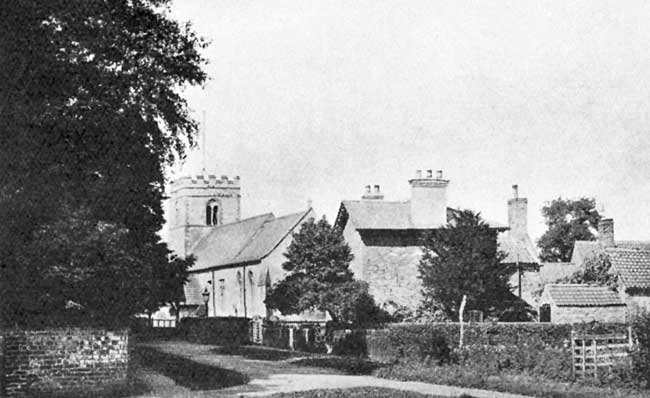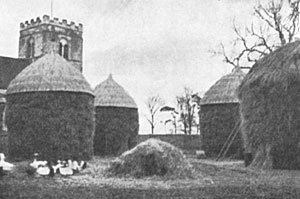Nottinghamshire Villages: Finningley
By Alfred Parker

The Pathway to the Church is shadowed with the beeches of the Rectory.
UP in the north of the county, where Nottinghamshire runs like the silhouette of an old three-cornered hat, between Lincolnshire and Yorkshire, lies the village of Finningley. One may well sympathize with those who, travelling north, are under the impression that they are in the county of broad acres, for the station is in that shire, and, by road from the south, one has crossed the county border twice, before reaching this very rural village.
Finningley spreads out from its spacious green, complete with pond, upon which "a stately elm casts its shadow." Ducks and duck-weed share the water, giving liveliness and colour to the scene, and one can imagine that here the "Bold Sir Brian Botany" met with the reward of his over-assertive behaviour.
Farmhouses, smithy and cottages in red brick and stone preserve an air which is not too generally met with nowadays, unmarred by the intrusion of unsightly petrol pumps.
The heavy, square tower of the church peeps above tiled roofs, for it stands tucked away aloof from the whirring traffic hurrying to Doncaster or Goole, an aloofness which the vicarage happily shares to some extent by virtue of its well-timbered surround.
Of the inns, one perpetuates a family name closely connected with the manor, while two others bear the quaint sign of "The Horse and Stag." That over the border, near the station, depicts the incident to which the name has reference in a very pleasing silhouette; and one cannot do better than quote the entry in the Parish Registers which throws enlightenment upon the title.
"These are to certify that I, William Romley, of Burton-upon-Stather, in the County of Lincoln, was Parish Clerk of Finningley when the Rev. Mr. Barnardiston was the Rector of the same; and was an eye witness of the following transaction which happened (as I remember) in or about the month of July, in the year of our Lord, 1707, viz:—Zechariah Bolton, riding with his gun on Mr. Barnardiston's bay horse into Aukley Colt-Field, found 5 staggs hirded about 200 yards from the bottom of the long hedge; he fired on them and disabled one in the hinder parts; then quitting his horse, he caught the stagg by the hind leg, and called to Jara Wood and myself (who were not far off) for help; but on the stagg struggling and braying, ye horse took him by the neck, and beat him with his fore-feet till he lay still. Then we took him alive, laid him on the horse, and carried him to the Parsonage House, at Finningley, into the little court before the kitching door, where he was killed and dressed by the order of John Harvey, of Ickwell-Bury, Esq., who was then present, and had given us an order to go about the said transaction. The truth of this I am ready to attest upon oath if required. Witness my hand this 25th day of June, 1739. Wm. Romley."
The antlers of the red deer were affixed to the kitchen wall at the Rectory as an added testimony of this somewhat unusual happening.

The close association of Agriculture with the Church is depicted.
In addition to these antlers, another reminder of past days was wont to jog the memories of its inhabitants. The spectre of a certain hunting parson, buried in the churchyard, developed a habit of appearing in the study of Dr. Lewis. The doctor was by no means scared at seeing this strange visitor and enquired why he was thus honoured. The deceased had a complaint to make, he was very concerned about the neglected state of the churchyard, and more particularly about the way in which his own place of sepulchre had been allowed to get into an untidy condition. The Rector, paying heed to this plaint, had matters attended to and the nocturnal visits ceased.
Travelling about the county one is tempted to wish that there were more of the sporting padres of the past who would make it their business to draw attention thus effectively when our church gardens become overgrown or untidy.
The Rev. Gervas Woodhouse in his interesting Memorial, which gives much information about the parish in his day, tells us that when he arrived in 1836 the Village School House occupied part of the churchyard, while the sacred enclosure did duty as a playground for the children. No wonder the old Rector turned in his grave!
It throws an interesting sidelight on the educational scheme of a century ago to read that the then schoolmaster, Charles Robinson, was also druggist and successful doctor.
We are also reminded that in those days the inhabitants of Finningley made the most of their opportunities for business and pleasure, for in connection with the clearing of the churchyard and the building of new schools, a meeting was called to make a final settlement but had to be postponed until the next day "because of Doncaster Fair."
A tablet on the school building itself records the solution of the problem of re-housing scholars and master—
"This school and the adjoining house were presented to the Parish of Finningley
and endowed with an annual income of twenty pounds
by
John Harvey, Esq.
of Ickwell-Bury.
A.D. 1855."
Generosity was by no means confined to the Lord of the Manor, for others, including the Rector, contributed money towards building and fitments and with the true team spirit "Neighbours kindly brought earth to the yard for the foundation of the playground," and the boarded floor was supplied from the proceeds of a Harvest Tea Party. We can well imagine that gathering; its like still lingers here and there, though our life is not so keenly dependent upon the results of a successful "harvest home" as was the case in the middle of last century.
This happy sense of family unity was brought out also in connection with the rebuilding of the Parsonage and Mr. Woodhouse records a long list of those who carted bricks from Melwood and Hatfield, ten and six miles distant respectively.
The list of benefactions set forth in the church date, for the greater part, to the seventeenth century, and the administration of the charities still remains in the hands of the vestry. A point of unusual interest in the organization of Finningley Church affairs is the appointment of a third warden known as "the King's Warden." Tradition has it that the king, riding through Blaxton after a stag hunt, was stopped by a farmer with a petition that Blaxton should have its representative at the Parish Church. The king replied that the man's wish should be gratified—"A churchwarden Blaxton shall have, and that churchwarden you and your successors shall be"—and henceforth there was an extra representative.
Auckley, though it has its Chapel of Ease, has not this special right.
